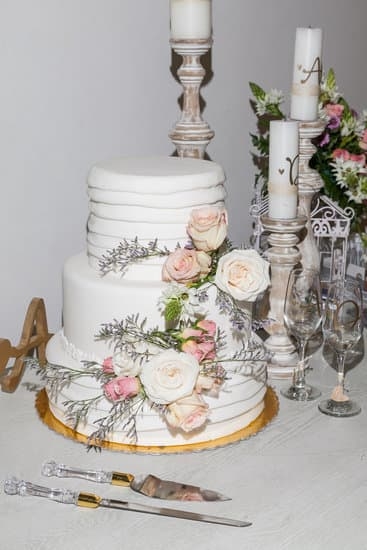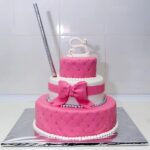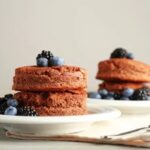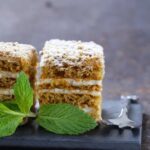What is cake decorating? Cake decorating is the art of transforming a simple cake into a masterpiece through various techniques, tools, and ingredients. It involves not only making the cake visually appealing but also enhancing its taste and texture to create a delightful culinary experience.
Cake decorating has a rich history that dates back centuries, with intricate designs and decorations being used to signify special occasions and celebrations. Over time, it has evolved into a creative form of expression where bakers can showcase their skills and imagination through beautifully decorated cakes.
To embark on a cake decorating journey, essential tools such as piping bags, tips, fondant, and edible decorations are required. Each tool plays a vital role in achieving different textures, shapes, and designs on the cake. With the right ingredients and tools in hand, bakers can explore various techniques such as buttercream piping, fondant sculpting, and royal icing flooding to bring their cake creations to life.
History of Cake Decorating
Cake decorating has a rich and intriguing history that dates back centuries. The art of adorning cakes can be traced to ancient civilizations, where elaborate designs were created using simple ingredients like sugar and marzipan. Over time, cake decorating evolved from being a luxury reserved for the wealthy to a mainstream practice enjoyed by people around the world. It wasn’t until the 17th century that cake decorating truly began to take shape as we know it today.
One of the key milestones in the history of cake decorating was the invention of baking powder in the mid-19th century. This innovation allowed for lighter and more fluffy cakes, which provided a better canvas for intricate decorations. As interest in baking and confectionery grew, so did the techniques and tools used for cake decoration. By the late 19th century, professional bakers were incorporating royal icing, buttercream, and fondant into their creations, giving rise to new possibilities in design.
In recent decades, cake decorating has experienced a renaissance with the advent of social media platforms like Instagram and Pinterest. Amateur bakers and professional cake decorators alike now have a vast array of inspiration at their fingertips, leading to an explosion of creativity in the field. Today, cake decorating has become not only about creating visually stunning cakes but also about showcasing unique styles and personal expression through edible artistry.
| Key Points | Details |
|---|---|
| Origin of Cake Decorating | Began in ancient civilizations with intricate designs using sugar and marzipan |
| Evolution of Techniques | Advancements like baking powder led to lighter cakes and more intricate decorations |
| Social Media Impact | Platforms like Instagram have sparked creativity and innovation in modern cake decorating |
Basic Tools and Ingredients
Cake decorating is an art form that requires the use of specific tools and ingredients to create visually stunning and delicious cakes. Whether you are a beginner or an experienced baker, having the right equipment is essential to achieve professional-looking results. Here is a breakdown of the basic tools and ingredients needed for cake decorating:
- Piping bags: Piping bags are essential for adding intricate details, writing messages, creating borders, and adding decorative elements to your cakes. They come in various sizes and materials, such as disposable plastic or reusable fabric.
- Tips: Piping tips are attachments that are used with piping bags to create different designs and shapes on cakes. From simple round tips for outlining to star tips for creating rosettes and shells, having a variety of tips in your collection can enhance your decorating skills.
- Fondant: Fondant is a versatile sugar paste that can be rolled out like dough and draped over cakes for a smooth finish. It can also be shaped into intricate decorations, figures, and flowers to add a creative touch to your cakes.
- Edible decorations: Edible decorations such as sprinkles, edible glitter, pearls, dragees, and edible images can add color, texture, and sparkle to your cakes. These decorations are perfect for adding a personalized touch to special occasion cakes.
Having these basic tools and ingredients on hand will not only make the cake decorating process easier but also allow you to explore your creativity and bring your cake designs to life.Experimenting with different techniques using these tools will help you develop your skills as a cake decorator.
Remember that practice makes perfect when it comes to cake decorating. Don’t be afraid to try new things and step out of your comfort zone. With the right tools and ingredients at your disposal, you can create beautiful works of art that not only look impressive but taste delicious too. So go ahead, unleash your creativity with cake decorating.
Techniques
Cake decorating is an art form that allows individuals to transform simple cakes into visually stunning and delicious creations. One of the key aspects of cake decorating is mastering various techniques to elevate the appearance of a cake. From buttercream piping to fondant sculpting and royal icing flooding, there are numerous methods that can be used to create intricate designs and decorations on cakes.
Buttercream Piping
Buttercream piping is a popular technique in cake decorating that involves using a piping bag and different tips to create intricate designs and patterns on cakes. Whether it’s creating rosettes, swirls, or intricate borders, buttercream piping allows decorators to add a personal touch to their creations. The key to successful buttercream piping lies in consistency – ensuring that the buttercream is at the right temperature and texture for easy manipulation.
Fondant Sculpting
Fondant sculpting is another technique commonly used in cake decorating, especially for creating 3D figures, shapes, and textures on cakes. Fondant is a versatile sugar paste that can be rolled out and molded into various shapes before being placed on top of the cake. Decorators can use fondant tools to sculpt details like flowers, animals, or even buildings to bring their cake designs to life.
Royal Icing Flooding
Royal icing flooding is a technique that involves using a thin consistency royal icing to create smooth and seamless designs on cookies or cakes. By outlining and flooding different sections with royal icing, decorators can achieve colorful and vibrant decorations on their baked goods.
This technique is often used for creating intricate patterns like lace designs or detailed illustrations on cakes for special occasions such as weddings or birthdays. Mastering these techniques allow decorators to unleash their creativity and bring their cake decorating visions to reality.
Styles and Trends
Cake decorating is not just about creating visually appealing cakes, but it is also a form of art that allows bakers to showcase their creativity and skills. In the world of cake decorating, there are various styles and trends that are constantly evolving. From minimalist designs with clean lines and simple decorations to rustic themes with natural elements like wood and burlap, the possibilities are endless.
Minimalist Style
Minimalist cake decorating focuses on simplicity and elegance. These cakes often feature clean lines, monochromatic color schemes, and understated decorations. A minimalist approach to cake decorating can create a modern and sophisticated look that is perfect for any occasion, from weddings to birthdays.
Rustic Theme
Rustic cake decorating embraces a more organic and natural aesthetic. These cakes often incorporate elements like burlap, twine, fresh flowers, and even wooden accents. Rustic cakes have a cozy and charming feel that is ideal for outdoor weddings, barnyard parties, or any event where a touch of countryside charm is desired.
Floral Designs
Floral cake decorating remains popular as ever in the industry. Whether using fresh flowers or creating intricate sugar flower arrangements, floral designs add a touch of romance and beauty to any cake. Floral cakes can range from simple flower accents to elaborate cascades of blooms, making them versatile for various occasions like anniversaries, baby showers, or even just because.
Keeping up with the latest trends in cake decorating can inspire bakers to try new techniques and styles in their creations. Whether following modern minimalist designs or embracing timeless floral motifs, cake decorators have the opportunity to push boundaries and express their unique artistic vision through their cakes.
Tips and Tricks
Cake decorating is an art form that allows individuals to express their creativity while making visually stunning and delicious cakes. For beginners looking to improve their cake decorating skills, there are several tips and tricks that can help elevate their creations.
One key tip is to ensure that the buttercream used for frosting is at the right consistency. If it’s too thin, the frosting won’t hold its shape, and if it’s too thick, it will be difficult to spread smoothly.
Another important tip for achieving smooth buttercream finishes is to crumb coat the cake before applying the final layer of frosting. A crumb coat is a thin layer of frosting applied to the cake before the final layer to seal in any crumbs and create a smooth base for decorating. This technique helps prevent crumbs from showing through the final layer of frosting, resulting in a professional-looking finish.
When it comes to creating vibrant colors in cake decorating, using gel food coloring instead of liquid food coloring can make a significant difference. Gel food coloring is more concentrated than liquid food coloring, allowing you to achieve more intense colors without adding excess liquid that could alter the texture of your frosting. Additionally, using white frosting as a base can help colors appear more vibrant and true to shade.
| Tip for Beginners | Explanation |
|---|---|
| Ensure proper buttercream consistency | It’s crucial for smooth application |
| Apply a crumb coat before final frosting layer | To prevent crumbs from showing through |
| Use gel food coloring for vibrant colors | More concentrated than liquid coloring |
Cake Decorating Classes and Workshops
Here are some benefits of enrolling in cake decorating classes:
- Learn from professionals: Instructors in cake decorating classes are often experts in their field, offering insider tips and tricks to help students improve their techniques.
- Hands-on practice: Classes typically provide the opportunity to practice different decorating techniques under the guidance of an instructor, allowing students to build confidence and skill.
- Networking opportunities: Attending workshops or classes can introduce you to other cake decorators, creating a sense of community and providing the chance to share ideas and experiences.
Many cake decorating classes also focus on specific themes or styles, such as wedding cakes or character cakes, allowing students to specialize in areas of interest. Additionally, workshops often include demonstrations of trending techniques or tools in the industry, keeping decorators up-to-date with the latest innovations.
Whether you’re a novice decorator looking to start your journey or an experienced pro seeking to refine your skills, cake decorating classes and workshops offer a supportive environment to grow as an artist.
Lastly, regularly attending cake decorating classes can spark creativity and motivation by exposing students to different styles and approaches. By continuously learning and practicing new techniques, decorators can push boundaries and develop their own unique artistic voice within the world of cake design.
Conclusion
In conclusion, cake decorating is not just about making a cake look good; it is a form of art that allows individuals to express their creativity and passion for baking. The history of cake decorating dates back centuries, with techniques evolving over time to create visually stunning and delicious cakes that cater to different styles and preferences.
By understanding the basic tools and ingredients needed for cake decorating, individuals can begin their journey into this creative world and explore various techniques such as buttercream piping, fondant sculpting, and royal icing flooding.
Moreover, staying updated on the latest styles and trends in cake decorating can inspire individuals to push their boundaries and try new designs. Whether it’s a minimalist approach, rustic charm, or intricate floral patterns, there is always something new to learn in the world of cake decoration.
Taking advantage of tips and tricks from experienced decorators can help beginners improve their skills and achieve smooth finishes with vibrant colors that will wow both the eyes and taste buds of those who enjoy their creations.
For those looking to further enhance their cake decorating skills, participating in classes or workshops can provide valuable hands-on experience and mentorship from experts in the field. These opportunities not only allow for skill development but also foster a sense of community among fellow enthusiasts who share a love for creating beautiful cakes.
Overall, what is cake decorating is more than just a hobby; it is a form of art that brings joy to both creators and consumers alike. So why not pick up some tools, roll out some fondant, and let your imagination run wild as you embark on your own cake decorating journey?
Frequently Asked Questions
What Does Cake Decorating Involve?
Cake decorating involves using various tools, techniques, and ingredients to enhance the appearance of cakes. This can include icing, fondant, piping, edible decorations, and intricate designs to create visually appealing treats that are not only delicious but also visually stunning.
What Is the Importance of Cake Decorating?
The importance of cake decorating goes beyond just making a cake look pretty. It adds a personal touch to special occasions like birthdays, weddings, and celebrations. Decorated cakes can evoke emotions, showcase creativity, and serve as a centerpiece for events. Furthermore, skilled cake decorating can turn an ordinary dessert into a work of art.
What Are Types of Cake Decorating?
There are several types of cake decorating techniques that bakers can utilize to bring their creations to life. These include buttercream piping, fondant sculpting, royal icing detailing, airbrushing, hand-painting on cakes, using edible images or wafer paper for designs, and working with gum paste for three-dimensional elements.
Each method requires different skills and tools but contributes to the overall aesthetics of the final product.

Welcome to our cake decorating blog! My name is Destiny Flores, and I am the proud owner of a cake decorating business named Cake Karma. Our mission is to provide delicious, beautiful cakes for all occasions. We specialize in creating custom cakes that are tailored specifically to each customer’s individual needs and tastes.





